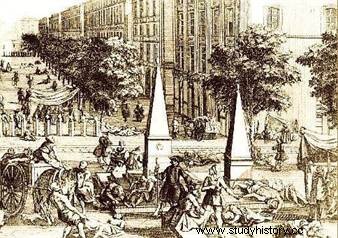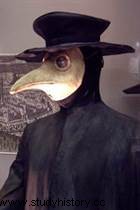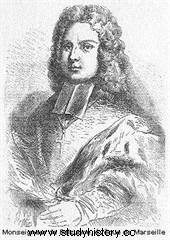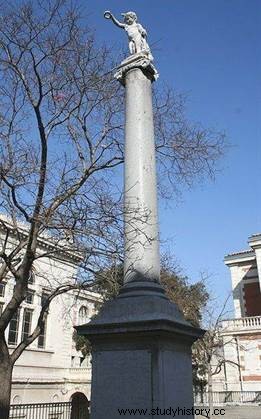 The last great manifestation in Europe of the Plague dated 1720 and remains known as the “plague of Marseille ". It will cause 40,000 victims out of the 75,000 inhabitants of the Marseille city, which is then experiencing its twentieth epidemic of this disease since antiquity. In the 15th century, the city was hit nine times. In the 17th century, thanks to the efforts of Cardinal Richelieu and then Louis XIV, suspicious ships could not dock, the port police were vigilant. Signed and countersigned health certificates were required before mooring and in view of these documents, quarantine was decreed or not. But under the Regency and freedom of morals, the situation was quite different….
The last great manifestation in Europe of the Plague dated 1720 and remains known as the “plague of Marseille ". It will cause 40,000 victims out of the 75,000 inhabitants of the Marseille city, which is then experiencing its twentieth epidemic of this disease since antiquity. In the 15th century, the city was hit nine times. In the 17th century, thanks to the efforts of Cardinal Richelieu and then Louis XIV, suspicious ships could not dock, the port police were vigilant. Signed and countersigned health certificates were required before mooring and in view of these documents, quarantine was decreed or not. But under the Regency and freedom of morals, the situation was quite different….
How did the plague come to Marseille in 1720?
On May 14, 1720, a Dutch flute, the Grand Saint Antoine, arrived in sight of one of the islands of the Frioul archipelago, opposite Marseille, loaded with precious fabrics and bales of cotton worth a hundred thousand crowns from Asia. For some, the boat, which left Seyde on January 31, had stopped in the ports where the plague epidemic was declared, in particular in Damascus. In Tripoli, the storm having damaged the sails, the boat recovered others from a ship whose crew had perished from the plague... For others, the boat would have all its clear patents, that is to say , targeted in ports not infested by the plague!
Despite everything, dead were declared on board:a passenger, seven sailors and the surgeon. The captain, aware that it was a serious illness, had stopped in Livorno and provided with a diagnostic certificate established by the Italians, mentioning a pestilential malignant fever, docked in order in Marseilles. Another sailor died on May 27.
The cargo belonging to Captain Chataud as well as notables from the city of Marseille, including Alderman Estelle, is unloaded after just four days to sell it at most quickly on the markets of Beaucaire. Usually, suspicious vessels are rigorously inspected and quarantined. Having a little doubt, the authorities decree a light quarantine towards the island of Jarre, the sailors will leave twenty days later only! But the scourge is in the streets of the city….
The first victims of the plague of 1720
 On June 20, a fifty-eight-year-old washerwoman collapsed in a street, a bubo at the corner of the lip. On June 28, in the same district, a tailor and his wife died, on July 1 another woman had a charcoal on her nose. It turns out that the first sufferers touched the cargo of fabrics and the plague-bearing fleas were in the folds of the fabrics; the bite made by the rat flea causes sepsis and after a maximum of three days the patient dies.
On June 20, a fifty-eight-year-old washerwoman collapsed in a street, a bubo at the corner of the lip. On June 28, in the same district, a tailor and his wife died, on July 1 another woman had a charcoal on her nose. It turns out that the first sufferers touched the cargo of fabrics and the plague-bearing fleas were in the folds of the fabrics; the bite made by the rat flea causes sepsis and after a maximum of three days the patient dies.
The disease spreads briskly with one or two deaths a day in an overcrowded city where hygiene is deplorable. On July 9, the doctors suspected the plague when they discovered a thirteen-year-old child affected and then informed the authorities. Guards are posted in front of the house. But the municipality tries to hide these deaths, so that the trade does not suffer. From that moment, we talk about the Plague - the bacillus being named Yersinia pestis from the name of the researcher Alexandre Yersin who discovered it in 1894.
Entire neighborhoods were affected when one of the associate doctors, Mr. Peyssonel, warned the aldermen on July 18 that the danger was present and pressing. During the day of July 23, fourteen people died in the same street…the population was frightened, the doctor insisted with the aldermen to make them understand that it was indeed the plague. As only reaction, guards are posted at the beginning of infected streets, sick bodies and other family members moved in the middle of the night….
Doctor Peyssonel alerted the neighboring towns which reacted quickly by prohibiting all trade and comings and goings of people with Marseille. This is how in the surroundings and beyond Languedoc, as far as Rodez and Toulouse, anyone coming from Provence is subject to quarantine, the goods are "ventilated" forty days and no trip is not possible without a health certificate. Postal and courier managers are required "to have letters from Marseilles and neighboring places perfumed in the presence of one of the local consuls".
Marseille trade is blocked, there will soon be no more food! Three markets are located two leagues from the city, one on the way to Aix, the other on the way to Aubagne and the last at Estaque, on the port for goods from the sea. thus buy provisions from sellers protected by a double barrier.
 Inhabitants increasingly worried, leaving the city, some in the hinterland on the heights, the others in a boat trying to take away their belongings. Soon, there are only the priests, the aldermen and a few inhabitants animated by the faith that the bishop of Belsunce spreads. Under his orders, militias are formed to clear infected houses, maintain order, and help the poorest. The "crows", these requisitioned men, take the corpses out of the houses to transport them in dump trucks but on the way steal the goods remaining from the former inhabitants.
Inhabitants increasingly worried, leaving the city, some in the hinterland on the heights, the others in a boat trying to take away their belongings. Soon, there are only the priests, the aldermen and a few inhabitants animated by the faith that the bishop of Belsunce spreads. Under his orders, militias are formed to clear infected houses, maintain order, and help the poorest. The "crows", these requisitioned men, take the corpses out of the houses to transport them in dump trucks but on the way steal the goods remaining from the former inhabitants.
The peak of the disease
As of July 30, there are forty deaths a day. Others are found nearby. August 9:100 dead. August 15:three hundred dead. A new contagion appears on August 21 which kills the sick, the remaining guards and some convicts. The surviving aldermen, including M Moustier, had to carry out the orders themselves, helped by a few unaffected men to remove the bodies by the hundreds. Hundred convicts are placed at the disposal of the alderman, but they die in 6 days, the corpses again litter the streets. Eight hundred people die a day. And from August 30:a thousand deaths a day.
Bodies are piled up everywhere, the "Cours", the most beautiful promenade in Marseilles, is strewn with sick people, all come to take shelter under the beautiful trees... the municipality, having more "crows" employ convicts to transport the bodies and up to twenty dumpers circulate constantly...All the dogs roam, die, they are thrown into the sea...the smell is more than pestilential with the heat and the sun .
The pits that have a dangerous infection are covered with lime, then with earth. Faced with the immensity of the number of corpses, other solutions had to be found. The churches are open, the vaults filled with all the bodies, the lime poured over them, so the streets are a little emptied of these horrors.
To try to stem the scourge, the remaining sick people are isolated, the houses are disinfected and smoked out and then the dead are cremated. The people helping wear the duck-billed mask, imagined by De Lorme, physician to Louis XIII, in which aromatic plants such as cloves and rosemary are placed. On their feet, they wear Levant morocco ankle boots, plain skin breeches, a shirt, hat and gloves all in skin.
Recipes from all over the world arrive in Marseille, made up of ingredients each more bizarre than the next:toad powder and pills with the heart and liver of vipers! Apparently, the most effective would be vinegar on a sponge that you place in front of your mouth. History also reports that three professions are spared from the plague:goatherds and grooms, the smell of animals would repel rat fleas and oil carriers because the oil would also repel them!
Personalities are devoted:the knight Roze and the galley slaves in his service will pick up and bury between one thousand and two thousand dead. The Bishop of Belsunce, whose clergy was decimated by the fifth, visited the sick every day, gave the holy sacraments and distributed large alms. The aldermen Moustier and Estelle, the painter Serre, the Admiralty lieutenant Gérin-Ricard, as well as doctors also participate.
In mid-September, entering and leaving Marseille is prohibited, the mail is disinfected, the fabrics and the boat are finally burned on the 26th on the island of Jarre . But it is much too late, because the bacillus has spread inland, as far as Provence and Languedoc. On September 21, there were four hundred dead.
Towards the end of misfortune
 At the end of September 1720, some poor people were seen, leaning on a stick which was nicknamed "the sticks of Saint Roch", to walk the streets in search of food. They survived the disease. By recounting their experience, we come to the conclusion that we do not catch the plague twice. Meanwhile, the inhabitants begin to return to Marseille, their astonishment is great when they discover a deserted and almost dead city.
At the end of September 1720, some poor people were seen, leaning on a stick which was nicknamed "the sticks of Saint Roch", to walk the streets in search of food. They survived the disease. By recounting their experience, we come to the conclusion that we do not catch the plague twice. Meanwhile, the inhabitants begin to return to Marseille, their astonishment is great when they discover a deserted and almost dead city.
Deaths decrease from October 1st. The beggars are sent to the Charité, the hospital becoming specialized in curing the plague. The Bishop of Belsunce places the city under the protection of the Sacred Heart of Jesus by celebrating a mass on November 1, 1720, with a procession and the offering of a candle bearing the arms of the city. On November 30, there are only two to five deaths per day.
The Papal States then built the Wall of the Plague in the Vaucluse (Gordes, Walls) to protect the Comtat Venaissin, a length of twenty seven kilometers, in dry stones. In March 1721 another wall, constantly guarded by the French troops to prevent any passage, was built to protect the surrounding territories, between the Durance and the Mont Ventoux in order to prevent any relationship between the Comtat Venaissin and the Dauphiné which was not not yet reached.
The following years
Marseille finished with the plague in February 1721. But the disease spread to Toulon and Aix en Provence. And yet, cases are recognized again in Marseille, in March-April with about two hundred and fifty deaths, these patients being much less contagious, they are only relapses.
Immediately, the aldermen act, close the gates of the city, a hospital for the rich and one for the poor are built, the poor being treated at the expense of the city. The epidemic stops. Calm returns, the inhabitants go out again and walk around, the survivors are happy to see each other again.
But in June, twenty people are again stricken with the disease. The doctors begin to reassure the population, and establish procedures. Each district is assigned a commissioner with workers under his orders who must clean all the houses marked with a red cross (where the infection is). After throwing everything away, three fumigations are made:one with aromatic herbs, one with gunpowder, the third with arsenic and other drugs. Then one or two coats of lime are thrown on the walls and floors.
The problem then arises for the boats, they must be disinfected and the goods sent to the neighboring islands. There remain the churches where all the bodies were stored in the vaults. The doors must be sealed and all the joints must be cemented. Last point to eradicate this scourge:find all the objects stolen during this period, because of course, once the inhabitants left their house, there were often thieves. A lot of research is being done, everyone is helping out and so the inhabitants can finally find their peace of mind.
Assessment of the 1720 plague in Marseille
 Marseille, whose population reached about ninety thousand inhabitants at the beginning of the year 1720, is reduced by half:forty thousand dead in the city and ten thousand in the vicinity. One hundred and twenty thousand dead are recorded in the south east.
Marseille, whose population reached about ninety thousand inhabitants at the beginning of the year 1720, is reduced by half:forty thousand dead in the city and ten thousand in the vicinity. One hundred and twenty thousand dead are recorded in the south east.
Captain Chataud, the originator of this scourge, is accused of deception and imprisoned. On September 8, 1720, he joined the Château d'If, charged with "contraventions of health orders, false declarations, of having brought in goods before the purge and of having favored the escape of a man from crew during quarantine”. On April 7, 1721, he joined the royal prisons of the Admiralty. He was forgotten...until July 8, 1723, when he was decreed "out of court and on trial" and then released on August 3.
A statue bearing the effigy of Bishop Belsunce was installed on the Cours in 1802, then moved to be currently on the forecourt of the Major Cathedral; in the center of the city, streets bear the name of the aldermen; a commemorative plaque was created in memory of the aldermen, it is visible at the Museum of the History of Marseille.
Bibliography
- Marseille Dead City:The Plague of 1720 . collective work. Another Time, 2008.
- The Curse of the Great Saint Anthony by Patrick Mouton. Another Time, 2001.
- Account of the plague in Marseilles in 1720, by Abbé Papon.
